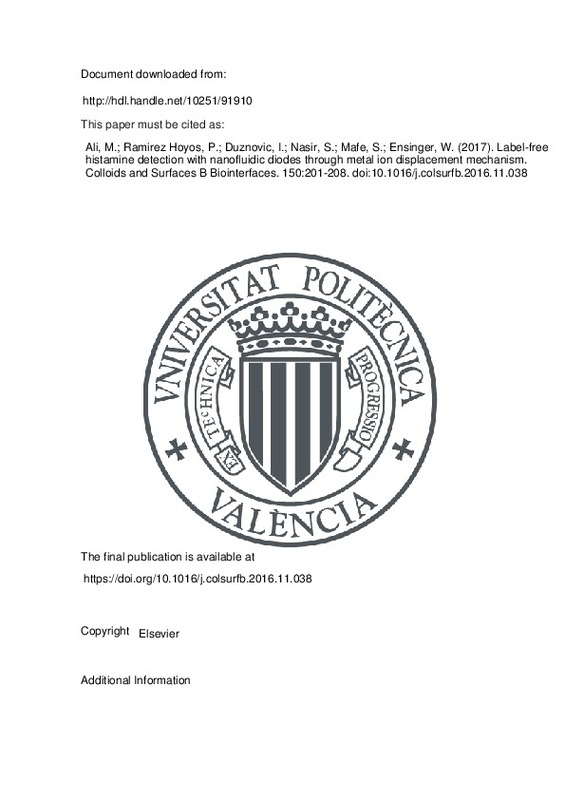JavaScript is disabled for your browser. Some features of this site may not work without it.
Buscar en RiuNet
Listar
Mi cuenta
Estadísticas
Ayuda RiuNet
Admin. UPV
Label-free histamine detection with nanofluidic diodes through metal ion displacement mechanism
Mostrar el registro sencillo del ítem
Ficheros en el ítem
| dc.contributor.author | Ali, Mubarak
|
es_ES |
| dc.contributor.author | Ramirez Hoyos, Patricio
|
es_ES |
| dc.contributor.author | Duznovic, Ivana
|
es_ES |
| dc.contributor.author | Nasir, Saima
|
es_ES |
| dc.contributor.author | Mafe, Salvador
|
es_ES |
| dc.contributor.author | Ensinger, Wolfgang
|
es_ES |
| dc.date.accessioned | 2017-12-04T10:45:24Z | |
| dc.date.available | 2017-12-04T10:45:24Z | |
| dc.date.issued | 2017 | es_ES |
| dc.identifier.issn | 0927-7765 | es_ES |
| dc.identifier.uri | http://hdl.handle.net/10251/91910 | |
| dc.description.abstract | [EN] We design and characterize a nanofluidic device for the label-free specific detection of histamine neurotransmitter based on a metal ion displacement mechanism. The sensor consists of an asymmetric polymer nanopore fabricated via ion track-etching technique. The nanopore sensor surface having metal-nitrilotriacetic (NTA-Ni2+) chelates is obtained by covalent coupling of native carboxylic acid groups with N-alpha,N-alpha-bis(carboxymethyl)-L-lysine (BCML), followed by exposure to Ni2+ ion solution. The BCML immobilization and subsequent Ni2+ ion complexation with NTA moieties change the surface charge concentration, which has a significant impact on the current-voltage (I-V) curve after chemical modification of the nanopore. The sensing mechanism is based on the displacement of the metal ion from the NTA-Ni2+ chelates. When the modified pore is exposed to histamine solution, the Ni2+ ion in NTA-Ni2+ chelate recognizes histamine through a metal ion coordination displacement process and formation of stable Ni-histamine complexes, leading to the regeneration of metal-free NTA groups on the pore surface, as shown in the current-voltage characteristics. Nanomolar concentrations of the histamine in the working electrolyte can be detected. On the contrary, other neurotransmitters such as glycine, serotonin, gamma-aminobutyric acid, and dopamine do not provoke significant changes in the nanopore electronic signal due to their inability to displace the metal ion and form a stable complex with Ni2+ ion. The nanofluidic sensor exhibits high sensitivity, specificity and reusability towards histamine detection and can then be used to monitor the concentration of biological important neurotransmitters. | es_ES |
| dc.description.sponsorship | M.A., I.D., S.N. and W.E. acknowledge the funding from the Hessen State Ministry of Higher Education, Research and the Arts, Germany, under the LOEWE project iNAPO. P. R. and S. M. acknowledge financial support by the Spanish Ministry of Economic Affairs and Competitiveness (MAT2015-65011-P) and FEDER. The authors are also thankful to Prof. C. Trautmann, Department of Materials Research from GSI, for support with irradiation experiments. | es_ES |
| dc.language | Inglés | es_ES |
| dc.publisher | Elsevier | es_ES |
| dc.relation.ispartof | Colloids and Surfaces B Biointerfaces | es_ES |
| dc.rights | Reserva de todos los derechos | es_ES |
| dc.subject | Neurotransmitter | es_ES |
| dc.subject | Histamine | es_ES |
| dc.subject | Surface functionalization | es_ES |
| dc.subject | Nanofluidic sensor | es_ES |
| dc.subject | NTA-metal complex | es_ES |
| dc.subject.classification | FISICA APLICADA | es_ES |
| dc.title | Label-free histamine detection with nanofluidic diodes through metal ion displacement mechanism | es_ES |
| dc.type | Artículo | es_ES |
| dc.identifier.doi | 10.1016/j.colsurfb.2016.11.038 | es_ES |
| dc.relation.projectID | info:eu-repo/grantAgreement/MINECO//MAT2015-65011-P/ES/NANOFLUIDICA DE POROS BIOMIMETICOS: NUEVAS APLICACIONES EN CONVERSION DE ENERGIA Y SENSORES%2FACTUADORES/ | |
| dc.rights.accessRights | Abierto | es_ES |
| dc.date.embargoEndDate | 2019-02-01 | es_ES |
| dc.contributor.affiliation | Universitat Politècnica de València. Departamento de Física Aplicada - Departament de Física Aplicada | es_ES |
| dc.description.bibliographicCitation | Ali, M.; Ramirez Hoyos, P.; Duznovic, I.; Nasir, S.; Mafe, S.; Ensinger, W. (2017). Label-free histamine detection with nanofluidic diodes through metal ion displacement mechanism. Colloids and Surfaces B Biointerfaces. 150:201-208. https://doi.org/10.1016/j.colsurfb.2016.11.038 | es_ES |
| dc.description.accrualMethod | S | es_ES |
| dc.relation.publisherversion | https://doi.org/10.1016/j.colsurfb.2016.11.038 | es_ES |
| dc.description.upvformatpinicio | 201 | es_ES |
| dc.description.upvformatpfin | 208 | es_ES |
| dc.type.version | info:eu-repo/semantics/publishedVersion | es_ES |
| dc.description.volume | 150 | es_ES |
| dc.relation.pasarela | S\342399 | es_ES |
| dc.contributor.funder | Hessisches Ministerium für Wissenschaft und Kunst, Alemania | |
| dc.contributor.funder | Ministerio de Economía y Competitividad | |
| dc.contributor.funder | European Regional Development Fund |







![[Cerrado]](/themes/UPV/images/candado.png)

